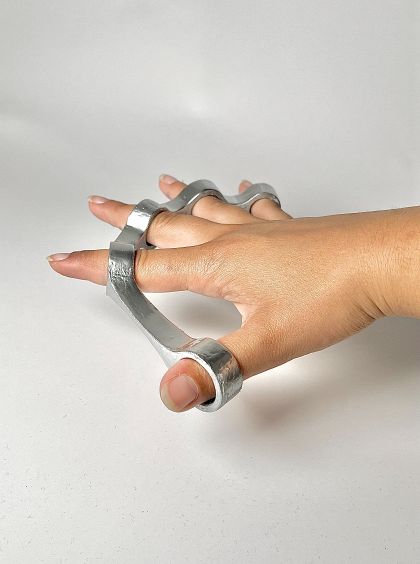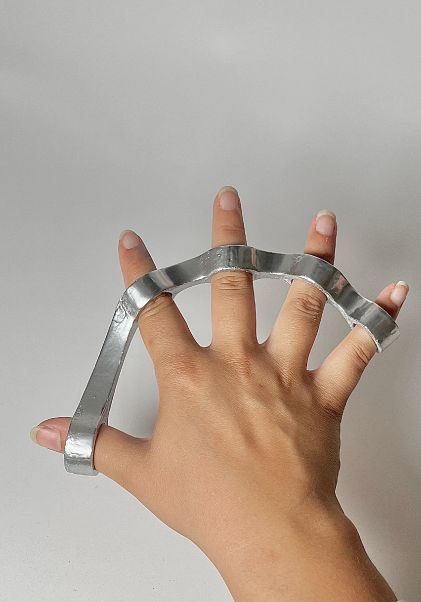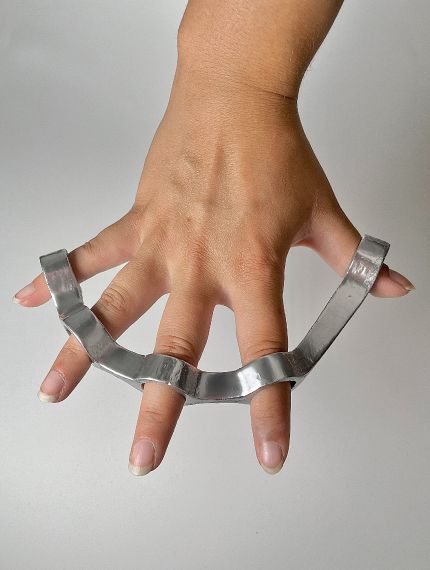No edit summary |
No edit summary Tag: 2017 source edit |
||
| Line 1: | Line 1: | ||
'''ex:vero''' | '''ex:vero''' | ||
[[File:Exvero.jpg|thumb|602x602px]] | [[File:Exvero2.jpg|thumb|564x564px]][[File:Exvero.jpg|thumb|602x602px]][[File:Exvero3.jpg|thumb|570x570px]] | ||
[[File: | |||
The interaction between human and object reveals the possibilities for action within our network and illuminates how our bodies and objects interact in a dynamic interplay of relationships. It aims to test the limits of the human body and questions the traditional master-servant dynamic between human and object. It provokes a re-evaluation of human agency and the agency of objects. | |||
This anti-thesis serves as an understanding and speculative exploration of how we interact with our environment and networks, as well as a provocative tool for exploring the dualistic categories of objects and subjects. This self-experience explores how our bodies are structured to understand the connections of our networks and to challenge conventional notions of how alternative body forms might alter our network of interactions and relationships. By preventing and abstracting everyday functions of the hands, this anti-orthesis causes a continuous restructuring of our perception and interaction with the environment, revealing the situatedness of human life realities, which enables awareness of other possible situatednesses and states.The interaction between human and object reveals the possibilities for action within our network and illuminates how our bodies and objects interact in a dynamic interplay of relationships. It aims to test the limits of the human body and questions the traditional master-servant dynamic between human and object. It provokes a re-evaluation of human agency and the agency of objects. | |||
Revision as of 21:07, 22 June 2024
ex:vero
This anti-thesis serves as an understanding and speculative exploration of how we interact with our environment and networks, as well as a provocative tool for exploring the dualistic categories of objects and subjects. This self-experience explores how our bodies are structured to understand the connections of our networks and to challenge conventional notions of how alternative body forms might alter our network of interactions and relationships. By preventing and abstracting everyday functions of the hands, this anti-orthesis causes a continuous restructuring of our perception and interaction with the environment, revealing the situatedness of human life realities, which enables awareness of other possible situatednesses and states.The interaction between human and object reveals the possibilities for action within our network and illuminates how our bodies and objects interact in a dynamic interplay of relationships. It aims to test the limits of the human body and questions the traditional master-servant dynamic between human and object. It provokes a re-evaluation of human agency and the agency of objects.
Drawing on Haraway's essay of "situated knowledge" and Bruno Latour's actor-network theory, this project aims to clarify the limits of the human* through the constraint of the hand and its grasping function, thereby stimulating a re-evaluation of human agency and the agency of objects*.
ANT serves as a framework for understanding this interaction, as it asserts that objects*/things have agency because they participate in networks of action, meaning and relationship, and thus the boundaries and dualisms of subject and object become fluid.
Above all, however, Haraway's rejection of universal objectivity and the assertion that all knowledge comes from a "situatedness" also serves as a design parameter. Donna Haraway is of the opinion that knowledge cannot be universally objectified, as it varies and is evaluated considerably depending on the context. This perspective also extends to the understanding of bodily functions, whereby a body that deviates from social physical norms experiences a different reality than a body that conforms to the norms. Haraway challenges the notion of objectivity and asserts that all knowledge is inherently subjective and embedded in a network of relationships.
These rings, as non-human actors, exercise agency by constraining human actions, thus changing the network of interaction and challenging views of domination and control. It promotes a new understanding of the complex and situational web of relationships that we refer to as our "objective" reality. By introducing conscious constraints and inversions, this anti-orthesis highlights often overlooked and unconscious dependencies and vulnerabilities in the relationship and boundaries between human* and object*.
The design is intended to evoke an expanded state of consciousness and encourages users to reflect on their cognitive processes and overall connectivity, transforming perceptions to serve as a stepping stone for a shift in self-perception and collective consciousness. The anti-orthesis creates a symbiotic relationship between people*and objects*and entities in which each influences and improves the state of the other. Through their interaction, the network of these objects* and their users* has the potential to evolve into a conscious entity that is constantly adapting and gaining complexity and understanding about itself, as a human being.
Diese Anti-Orthese dient dem Verständnis und der spekulativen Erforschung der Interaktion mit unserer Umwelt und Netzwerken,wie auch als provokatives Werkzeug zur Erforschung der Dualistischen Kategorien von Objekten und Subjekten. Diese Selbsterfahrung untersucht, wie unser Körper strukturiert ist um die Verbindungen unserer Netzwerke zu verstehen und konventionelle Vorstellungen zu hinterfragen , wie alternative Körperformen unser Netzwerk von Interaktionen und Beziehungen verändern könnten. Indem sie alltägliche Funktionen der Hände verhindert und abstrahiert, bewirkt diese Anti-Orthese eine kontinuierliche Umstrukturierung unserer Wahrnehmung und Interaktion mit der Umwelt und offenbart die situiertheit der menschlichen Lebensrealitäten, welche das Bewusstsein für weitere möglichen Situiertheiten und Zustände ermöglicht.
Die Interaktion zwischen Mensch und Objekt offenbart die Handlungsmöglichkeiten innerhalb unseres Netzwerks und beleuchtet, wie unsere Körper und Objekte in einem dynamischen Wechselspiel und Beziehungen interagieren. Es soll die Grenzen des menschlichen Körpers aus und stellt die traditionelle Herr-Diener-Dynamik zwischen Mensch und Objekt in Frage testen und provoziert eine Neubewertung der menschlichen Handlungsfähigkeit und der Handlungsfähigkeit von Objekten.
Auf der Grundlage von Haraways Essay des „situierten Wissens“ und der Akteur-Netzwerk-Theorie Bruno Latours zielt dieses Projekt darauf ab, die Grenzen des Menschen* durch die Einschränkung der Hand und ihrer Greiffunktion zu verdeutlichen und dadurch eine Neubewertung des menschlichen Handelns und des Handelns von Objekten* anzuregen.
Die ANT dient als ein Rahmen für das Verständnis dieser Interaktion,da sie behauptet, dass Objekte*/Dinge Handlungsfähigkeit besitzen, da sie an Handlungs- und Bedeutungs- und Beziehungsnetzwerken teilnehmen und somit die Grenzen und Dualismen von Subjekt und Objekt fluid werden.
Vorallem aber auch Haraways Ablehnung einer universiellen Objektivität und der Berhauptung alles Wissen komme aus einer „Situiertheit“ dient als Gestaltungsparameter. Donna Haraway vertritt die Auffassung, dass Wissen nicht universell objektiviert werden kann, da es je nach Kontext erheblich variiert und bewertet wird. Diese Perspektive erstreckt sich auch auf das Verständnis von Körperfunktionen, wobei ein Körper, der von den gesellschaftlichen physischen Normen abweicht, eine andere Realität erfährt als ein Körper, der den Normen entspricht. Haraway stellt den Begriff der Objektivität in Frage und behauptet, dass alles Wissen von Natur aus subjektiv und in ein Netzwerk von Beziehungen eingebettet ist.
Diese Ringe als nicht-menschliche Akteure üben Handlungsmacht aus, indem sie menschliche Handlungen einschränken und so das Interaktionsnetzwerk verändern und Ansichten von Herrschaft und Kontrolle in Frage stellen. Es fördert ein neues Verständnis des komplexen und situtionellen Beziehungsgeflechts, was wir als unsere „objektive“ Realität bezeichnen. Durch die Einführung bewusster Einschränkungen und Umkehrungen zeigt diese Anti-Orthese oft übersehene und nicht bewusste Abhängigkeiten und Schwachstellen in der Beziehung und Grenzen zwischen Mensch* und Objekt* auf.
Das Design soll einen erweiterten Bewusstseinszustand hervorrufen und regt die Benutzer* dazu an, über ihre kognitiven Prozesse und die umfassende Konnektivität nachzudenken und Wahrnehmungen so zu transformieren, dass sie als Trittbrett für eine Veränderung der Selbstwahrnehmung und des kollektiven Bewusstseins dienen sol lund schafft eine symbiotische Beziehung zwischen Menschen*und Objekten* und Entitäten, in der jeder den Zustand des anderen beeinflusst und verbessert. Durch ihre Interaktion hat das Netzwerk aus diesen Objekten* und ihren Nutzern* das Potenzial, sich zu einer bewussten Einheit zu entwickeln, die sich ständig anpasst und an Komplexität und Verständnis über sich selbst gewinnt.
*sprachliche Verwendung der konventionellen Definitionen und Grenzen um eine verständliche Inhaltsvermittlung zu erschaffen


